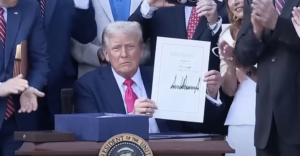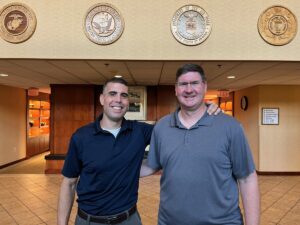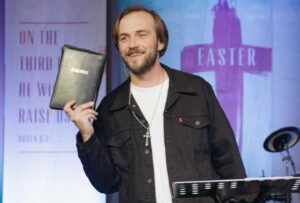
BIRMINGHAM, Ala. (BP)–Christian leaders should dare to dream of goals that seem improbable or even impossible, a NASA scientist told a group of about 30 conferees at Samford University’s Beeson Divinity School Feb. 6-7.
“The way we typically look at the future is through … what we extrapolate, what we know, what we are comfortable with and what our faith tells us is possible — but we all know that the future is bigger than what we can see or conceive of,” said John L. Anderson, a nuclear physicist who spoke at the Birmingham, Ala., school’s Global Mission Center.
Anderson, based at NASA’s Washington headquarters, led the conferees through “Horizon Mission Methodology,” which he designed to help NASA personnel think creatively about the future but can be applied to other areas, such as business, the military, education and religion.
Horizon principles call on participants to: 1) describe a possible future where a desired, lofty goal has been achieved and 2) come “back to the present,” by speculating about strategies, programs, forces and other factors that might have led to such an accomplishment.
Anderson told the Beeson conferees that one of his first attempts to apply the methodology was met with resistance from a few NASA engineers, but the results were eventually surprising to the once-skeptical scientists.
Anderson said he had assigned the NASA group the task of “leapfrogging” to the year 2050 and describing how a mission to Jupiter would take place.
Surely, the scientists told him, it would be more plausible to plan a mission to Mars. But Anderson pushed further.
He said they should assume the trip to Jupiter would take only a month — an idea that seemed more like fantasy since current technology, at its very best, could perhaps cut the trip to six months, but more likely closer to two years.
Still, by the end of the NASA workshop, the scientists had theorized a way to combine two high-level technologies — “space laser power beaming and inertial confinement fusion” — to travel to Jupiter in two months.
But Anderson assigned the Beeson workshop a more down-to-earth but perhaps equally improbable scenario. He told conferees to assume that in the year 2050 the continent of Africa has become a prosperous global power.
Participants divided into three “breakout groups” and reported back to the whole group a few hours later. Their resulting descriptions of a future Africa envisioned a continent with an interstate highway system, a common language, the absence of international conflict, the mobility of all Africans, bustling tourism, churches exemplifying biblical Christianity and a plentiful supply of food, housing and safe drinking water.
Anderson sent conferees back to their breakout groups where they speculated on how such an African transformation could have taken place. They considered what strategies, programs, forces and other factors could have led to such an “African miracle.”
The group named several possibilities, including:
— leadership development of African Christian leaders who would spread a “kingdom ethic” across the continent, with a special emphasis on outreach to government leaders.
— discovery of technology to use desert sand as a primary element in building roads and homes.
— encouragement of African expatriates and descendants, including American sports figures, to invest financially in their home continent.
— building of relationships between Christian leaders worldwide and officials in transnational corporations, especially Christian executives, who would be encouraged to provide industrial capital for African development.
— teaching Swahili as a primary language and English as a second language in African schools.
William R. O’Brien, director of Beeson’s Global Mission Center, praised the methodology and told conferees he had learned about it in an article by Anderson for the fall 1995 issue of Futures Research Quarterly.
When the workshop concluded, several conferees said they found Anderson’s principles valuable.
Denton Lotz, general secretary of the Baptist World Alliance, said the workshop was “a significant and mind-boggling experience that could transform the way the church thinks of mission in the 21st century.
“HMM presents us with a process of planning for the future by ‘visioning’ the future. Of course as Christians, we know the future belongs to Jesus Christ and therefore as missiologists, we must open ourselves to participating in the coming of the kingdom of God in Christ’s way.”
Terry York, a widely published writer who formerly worked at the Baptist Sunday School Board, said, “For me, the entire strength and benefit of the conference comes from the single image of planning from the future instead of planning for the future.
“I’ve tried to keep myself aware throughout the workshop that what we’re really doing is exploring a new methodology of planning. Africa is simply a case study; it could have been anything,” said York, who is now associate pastor of Park Cities Baptist Church in Dallas.
Njeri Gakonyo, a doctoral student in agricultural economics at Cornell University and a native of Kenya, said she feels the Horizon concepts are practical.
“I think it’s very useful because it’s teaching us to think and dream without restraints,” said Gakonyo, who is a member of a nondenominational church in Kenya. “It’s not something we often do. I think we really stunt our creativity because of always being so much aware of the constraints and trying to build the solutions within them, rather than saying, ‘What if the constraints weren’t there?'”
James Mageria, who until recently was vice president for Africa of World Vision International, noted the inclusion of several Africans in the conference and praised the participants’ attitudes toward helping Africa.
“We are used to people discussing Africa and then sending some envoy to us, telling us what we should be doing,” said Mageria, who recently became chief executive officer of Vision Africa. “For us to be invited to participate is really a great breakthrough, because it brings real partnership and not paternalism. You really are helping us with us, not without us.”
–30–














